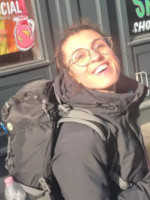Research Interests:
Quantum Foundations; Decoherence and Open Quantum Systems; Quantum/Gravity Interplay
Journal Articles
2024
Figurato, Laria; Dirindin, Marco; Gaona-Reyes, José Luis; Carlesso, Matteo; Bassi, Angelo; Donadi, Sandro
On the effectiveness of the collapse in the Diósi–Penrose model Journal Article
In: New J. Phys., vol. 26, no. 11, 2024, ISSN: 1367-2630.
@article{Figurato2024b,
title = {On the effectiveness of the collapse in the Diósi–Penrose model},
author = {Laria Figurato and Marco Dirindin and José Luis Gaona-Reyes and Matteo Carlesso and Angelo Bassi and Sandro Donadi},
doi = {10.1088/1367-2630/ad8c77},
issn = {1367-2630},
year = {2024},
date = {2024-11-01},
journal = {New J. Phys.},
volume = {26},
number = {11},
publisher = {IOP Publishing},
abstract = {Abstract
The possibility that gravity plays a role in the collapse of the quantum wave function has been considered in the literature, and it is of relevance not only because it would provide a solution to the measurement problem in quantum theory, but also because it would give a new and unexpected twist to the search for a unified theory of quantum and gravitational phenomena, possibly overcoming the current impasse. The Diósi–Penrose model is the most popular incarnation of this idea. It predicts a progressive breakdown of quantum superpositions when the mass of the system increases; as such, it is susceptible to experimental verification. Current experiments set a lower bound
R
0
≳
4
R
0
≲
10
6
},
keywords = {},
pubstate = {published},
tppubtype = {article}
}
Figurato, Laria; Bassi, Angelo; Donadi, Sandro
On the testability of the Károlyházy model Journal Article
In: New J. Phys., vol. 26, no. 1, 2024, ISSN: 1367-2630.
@article{Figurato2024,
title = {On the testability of the Károlyházy model},
author = {Laria Figurato and Angelo Bassi and Sandro Donadi},
doi = {10.1088/1367-2630/ad1499},
issn = {1367-2630},
year = {2024},
date = {2024-01-01},
journal = {New J. Phys.},
volume = {26},
number = {1},
publisher = {IOP Publishing},
abstract = {Abstract
Károlyházy’s original proposal, suggesting that space-time fluctuations could be a source of decoherence in space, faced a significant challenge due to an unexpectedly high emission of radiation (13 orders of magnitude more than what was observed in the latest experiment). To address this issue, we reevaluated Károlyházy’s assumption that the stochastic metric fluctuation must adhere to a wave equation. By considering more general correlation functions of space-time fluctuations, we resolve the problem and consequently revive the aforementioned proposal. },
keywords = {},
pubstate = {published},
tppubtype = {article}
}

Biography
Graduated in Physics at "Sapienza" University of Roma in 2017 (Bachelor) and in Astronomy and Astrophysics in 2021 (Master). She is currently a PhD student at the University of Trieste, working on Quantum Foundations.